Three Anadama Loafs, all of which are failures of one kind or another
The Anadama Myth
Everyone repeats the tired old folk tale about the origins of this loaf: the fisherman who cursed Anna, his wife, because she took off and left him to make his own meal (What's up with that, anyway? Why did that deserve a curse?). He supposedly tossed together some cornmeal and flour and molasses and baked this bread. It's purely apocryphal. It's not even nice.
I suggest another etymology. I say it was made by the family of a New England merchant mariner, recently back from the far east. While in India, he had picked up a few words in Sanskrit. To celebrate his arrival home safely, a great feast was put together. His mother put together the ingredients of the bread, using the freshest and best of New England grains, and she asked her son how he liked it. After eating nothing but sailor's hardtack for so many long months, he took a bite, sighed deeply and he told her, "Ananda, ma."
In Sanskrit, ananda means "bliss". Over the years, "Anandama Bread" became "Anadama Bread".
The Merchant Marine Clipper Anadama,
back from a trip to the Anadaman Islands in the Bay of Bengal, ca. 1712,
to the colonies of New England
Today is Anadama Day at our house. I like that.
I like my myth better than the offensive original bread myth. I say we take the curse out of this bread. Leave it full of nothing but good thoughts, homecoming, positive energy, and love.
The Reality
I have never made an Anadama Bread before. And the next Reinhart bread that I will be making is going to be his whole grain version of an Anadama bread. So I thought that I would have a look at other versions of the Anadama bread before I launch myself into making Reinhart's. I checked the wiki on Anadama then perused some of my recipe books. At least four of my recipe book authors have Anadama breads, including Reinhart (who has two), the Healthy Bread in Five Minutes a Day people, Ojakangas, and James Beard.
James Beard wrote:
"There are many recipes for this famous American loaf. No two people agree on what the original was, but it is practically certain that it contained cornmeal and molasses. I have had interesting Anadama breads made with graham flour, white flour, and cornmeal. It can be made with brown sugar or raw sugar instead of molasses."
Here are a few other Anadama recipes I found online:
- This one uses the recipe from the venerable Fanny Farmer Cookbook ca 100 yrs ago
- This one is from the Boston Globe Cookbook, ca 1948
- This one is an earlier Reinhart Recipe, from Bread Baker's Apprentice...
- ...and another version of Reinhart's BBA recipe here too.
- One from the Yellow Farmhouse Cookbook (and a traditional version from 'Great Aunt Nora')
- A quick Anadama using buttermilk and Baking Soda (which got mixed reviews on the taste)
After telling us that there are no longer any authentic Anadama recipes, Beard proceeds to give his version. I decided to make it (even though it contains no whole wheat flour, only all-purpose flour) because it is a simple, direct method. I may try other Anadama bread recipes too, before moving on to Reinhart's. If Reinhart's bread is not substantially tastier, why make a 2-day bread when you can make it in 1-day (or 5 minutes/day)?
I figured I would weigh the ingredients and then make it again using only whole wheat flour. Beard never weighs his ingredients, and he prefers a lot of sugar and salt; so I didn't think that the first loaf, using all-purpose flour, would be anything I'd like -- not to mention that I'm not that big a fan of molasses in bread anyway.
I am making this bread mostly to see what kind of consistency the dough achieves: that way, I can try to duplicate it, or approximate it, using whole wheat.
Thoughts on Whole Wheat
a) Can't you just substitute Whole Wheat for All Purpose?
There is another reason I am making this recipe out of whole wheat too. A lot of people I know think that you can just substitute whole wheat flour for all purpose or bread flour and achieve the same results. This kind of thinking comes from those who have never baked any kind of bread (I was guilty of thinking this myself, once). There is a reason that all purpose and bread flours have less bran in them. Those all-purpose and bread flours are fun to work with, and make airy bread that rises nicely. The gluten is like magic. It is the non-obvious case where "less is more": you take something out (the bran, the germ), and you get more (gluten and rising ability). Unfortunately, you do also get something less: you get less nutrition, and I think taste.
b) Why doesn't the gluten form, in whole wheat? Surely all the ingredients are still there?
The explanation that we have been given, i.e. that bran is sharp and slices the gluten as it forms out of the two smaller hydrated proteins when you mix up flour, is not satisfying to the intellect. It could be that, or it could be something else. I suspect that there may be another reason, having to do with the colloidal qualities of the bran: in other words, the bran is going to draw the water toward itself, and away from the forming gluten. I have seen this in dough that I made with all-purpose flour, when I add bran and water later. The gluten strands fall apart. And it isn't that it feels like you are adding tiny shards, it feels like you are adding goo. But it doesn't seem to matter: the fiber in the bran seems to draw more and more water to it, and it will even take it from the gluten that has already formed. Well, that is my opinion, anyway. The point being, if you add enough water, perhaps the gluten will have a chance to form despite the bran. In theory. Of course, there is going to be a point where too much water is just going to leave you with soup rather than dough.
Ingredients
There isn't any egg in the recipe;
but I included them in the picture because I'm just so damned proud of my chickens.
I repeat: the eggs in this picture are just for decoration.
I repeat: the eggs in this picture are just for decoration.
Ingredients by what I weighed (your mileage may vary):
- 6 g Instant Dry Yeast (Beard uses Active Dry Yeast, and I converted it)
- 4 g Brown Sugar (Beard uses white sugar here)
- 305 g warm water (100-115 degrees: the heat is to dissolve the ADY, and to dissolve the IDY the temperature can be a bit hotter, according to this conversion chart )
- 30 g butter
- 85 g molasses
- 8 g salt (I used kosher)
- 77 g yellow cornmeal
- 666 g all purpose flour (The flour is added 1 cup at a time, and it is to be kneaded until one achieves a kneadable dough, smooth and springy. I achieved that with 63 g of this amount left over, about 1/2 c; so I really only used about 600 g).
| Ingredient | % | ap amount |
| Flour | 100 | 603 g |
| ID Yeast | 1 | 6 g |
| cornmeal | 13 | 77 g |
| Water | 51 | 305g |
| Salt | 1.3 | 8 g |
| Molasses | 14 | 85 g |
| Sugar | .66 | 4 g |
| Butter | 5 | 30 g |
If you count the water and the molasses as total hydration, this loaf is only 65% hydrated. I am pretty certain I will have to increase that for the whole wheat version (I think I proved this, later).
Method
To warm the water I microwaved it for a minute and then tested the temperature. It was almost 140 degrees F. Although IDY can use a bit higher temperature, this is still a bit too hot. So I poured my 1/4 c into the measure I used for the molasses, and then into the cold bowl. This brought the temperature down to just below 130 degrees. I waited a bit longer to let it cool some more, and then I added the yeast and brown sugar.
Add the water and the yeast and sugar
The other ingredients are mixed in a saucepan, and then the lukewarm mixture is added to the yeast, and then the flour is added to that.Mix the molasses, salt, butter, and rest of water
Lukewarm liquid mix to the yeasty mix
Add the cornmeal
Add the flour a cup at a time until you can knead it
Turn it out onto a floured surface and knead, adding flour until you can't.
I could only add about 600 g
The heat of the mixtures and your kneading helps the gluey stuff come together. I found it very easy to mix, up until the last 1 1/2 cups of flour. It was not that the dough was stiff, but rather that it just felt like it had reached its flour saturation point. With still 1/2 a cup to go, the flour just wouldn't combine with it any more. I just left 63 g out. It could be that my flour is substantially different from the flour Beard was using.
I made this bread to discover how it felt. So how did it feel? Not smooth, but kind of gritty. I'm not convinced it was springy, either. But it felt warm, and cohesive, and soft.
Let it double in an oiled bowl
I put this in an oiled bowl and covered it.Then I did something else I've never done. I put it into my new Excaliber 9-tray drying unit. This has a low setting that can be used to raise bread. I covered it and set it in there to proof. Beard wants it to double before punching it down. I put it in there for 45 minutes at about 110 degrees, and it came out nicely.
Divide the dough, form it, and put it into the oiled tins
I divided it and put it in tins and set it to rise again (go, Excaliber!) for another 45 minutes.
It did see quite a substantial rise while proofing, but there was no oven spring, and I was a bit disappointed with that, as the loaves turned out a trifle flat. Perhaps I needed to let it sit in Excaliber for another 15 minutes, who knows? "At any rate, if these all-purpose loaves are going to be flat, I won't care if my whole wheat loaves are also a bit flat," I thought to myself.
The final All Purpose Flour Anadama loaves were a trifle flat
but had a nice rustic textured appearance
but had a nice rustic textured appearance
The crumb of the All Purpose loaf has a yellowish cast, and is fairly dense
This bread smells like molasses but only tastes sweet (there is no molasses taste). It quickly burns in the toaster, suggesting to me that it has a very high sugar content. While appearing dense, it is lightweight.
Now for the First Whole Wheat Experiment
Whole wheat flour this time
I mixed up the whole wheat dough in precisely the same way, proofing the yeast in warm water, adding the wet ingredients and the corn meal, and then 1 cup of flour at a time.Yeast and wet mixed ingredients are added
As expected, this dough got very stiff very fast. I was thinking of adding some extra hot water, but decided not to, as this original experiment is simply to show that, all else being equal, whole wheat flour doesn't perform the same as all purpose.
Add the whole wheat flour a cup at a time until you can knead it
then add more as you knead until the flour is all incorporated
I almost was unable to incorporate all the flour into the dough again, and just like before I almost stopped with 1/2 cup of flour still to be added. This time, however, I persevered -- because I had already cut Beard's amount by 1/2 cup, as you have seen. I kneaded and kneaded until my wrists were sore, but I did get the whole 600 g of whole wheat flour incorporated. But now the ball of dough was very very tight, and I really didn't think that it was hydrated quite enough for the yeast to make it rise.
After 1 1/2 hours, not much rise
So how did this dough feel? This dough didn't feel anything like the all-purpose loaves. It was tight, and dense, and heavy, and kind of gritty And you feel that if you stretch it at all, the dough is going to tear, not elongate. This wouldn't have passed any kind of window pane test, not by any stretch of the imagination. In fact, this would have been a decent kind of mortar for a log cabin. Not only no light would get through, but no wind would either.
I put it in my Excaliber proofing unit and let it rise for 45 minutes. From what I could see, it had done nothing in that time. So I kept it in my warmer/dehydrator for another 45 minutes.
Form the loaf and put it in a tin
It still didn't look like it had risen at all. Nevertheless, I took it out and formed a single loaf (remember, Beard's AP flour'd Anadama recipe made two loaves), and I placed it in an oiled and floured tin. Then I put that back into the warming cupboard to rise (again?). I left it 45 minutes...then 1 1/2 hours... then 3 hours. It did rise a bit, but not very much.
A tiny bit of rise after 3 hours
Eventually, I decided I just had to get on with it, and I baked it.
I spritzed the top with water and sprinkled a bit of whole wheat flour on before baking
This was going to be one dense loaf.
This is one dense loaf
The resultant log, when it came out of the tin, was so dense and heavy, you think it would burn forever in a fireplace. If I run out of wood this winter, I know what to do: I'll just make this one again. Remember, this single loaf has as much flour as the other two loaves put together, by weight. There is a lot less air, a lot less gas given off by the yeast that tried to ferment it. They might have been able to achieve more, given enough time. But they probably still would have required a lot more hydration to accomplish it.
Huh. Maybe this loaf is cursed.
I really should try to make this again but with more hydration.
You thought the all purpose Anadama oaves were dense? This whole wheat Anadama loaf is yet denser. This loaf looks like it was put together under high-gravity conditions (like what you would expect on a planet circling a neutron star). You can see where I rolled it up: it doesn't look cooked, exactly. But it is (I think). It is crumbly. There are stress lines in the dough that have become fault lines. In this bread, you don't see the yellowish cast that comes probably from the corn meal and the molasses. Speaking of molasses, this bread doesn't smell or taste like molasses. But it does taste sweet. And although I suspect it will go stale very quickly, so far it actually is moist -- leaving me to wonder how to get a dough and loaf to hold together at all with a higher hydration.
Huh. Maybe this loaf is cursed.
The small, dense whole wheat Anadama loaf beside two kiwis.
(The small dense loaf is the one on the left)
I really should try to make this again but with more hydration.
Crumb of the Whole Wheat Anadama. Looks uncooked.
You thought the all purpose Anadama oaves were dense? This whole wheat Anadama loaf is yet denser. This loaf looks like it was put together under high-gravity conditions (like what you would expect on a planet circling a neutron star). You can see where I rolled it up: it doesn't look cooked, exactly. But it is (I think). It is crumbly. There are stress lines in the dough that have become fault lines. In this bread, you don't see the yellowish cast that comes probably from the corn meal and the molasses. Speaking of molasses, this bread doesn't smell or taste like molasses. But it does taste sweet. And although I suspect it will go stale very quickly, so far it actually is moist -- leaving me to wonder how to get a dough and loaf to hold together at all with a higher hydration.
Crumb shot of my Anadama loaves together
Notes to Myself
- Consider adding more hydration to whole wheat loaves, to make sure that both the bran and the gluten have enough hydrogen to make their respective colloidal suspension and protein strands.
- The IDY doesn't need to be pre-hydrated and proofed like this, supposedly. If you do proof the yeast, it can apparently tolerate a higher temperature of water.
- If you are making a moister loaf for the whole wheat version, consider baking it in a covered oven-proof casserole dish. Consider hydrating it to the point where you can't knead it.
- Using whole wheat, you actually might be better off to put it in a soaker or get it fermenting and hydrated early -- even leave it overnight if you have to. Maybe Reinhart is on to something.
- You can choose whatever myth you will believe. But what else are you swallowing when you believe a myth?




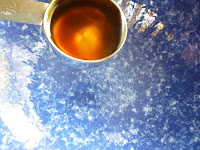
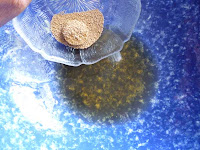


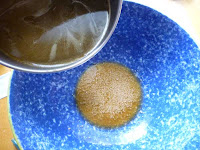




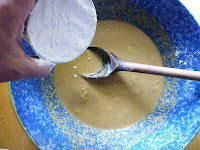




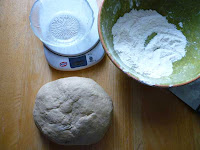






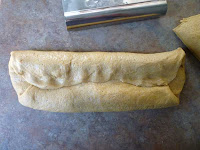
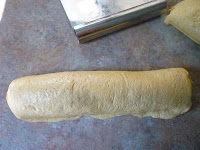
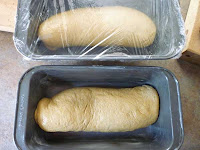

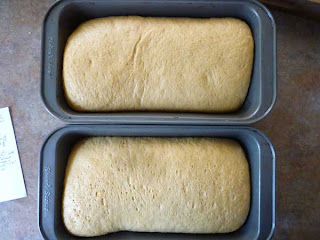
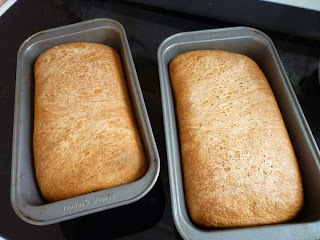
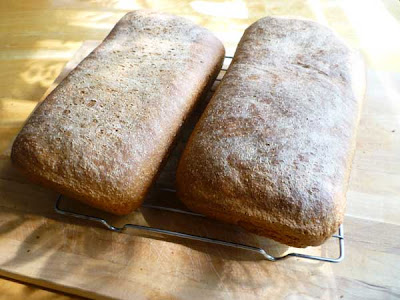
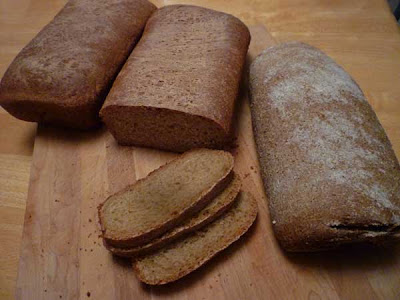
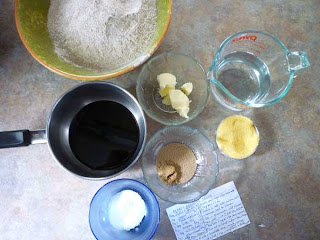

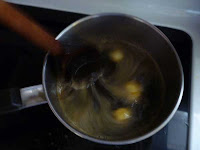



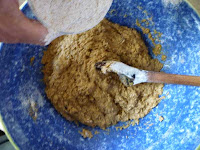


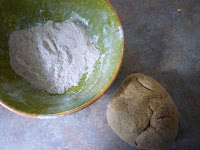

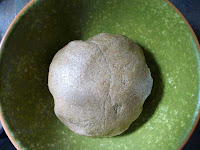


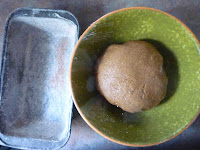
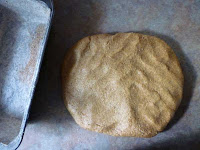



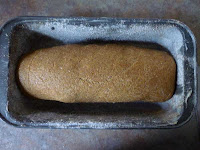
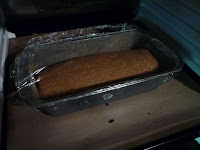









No comments:
Post a Comment